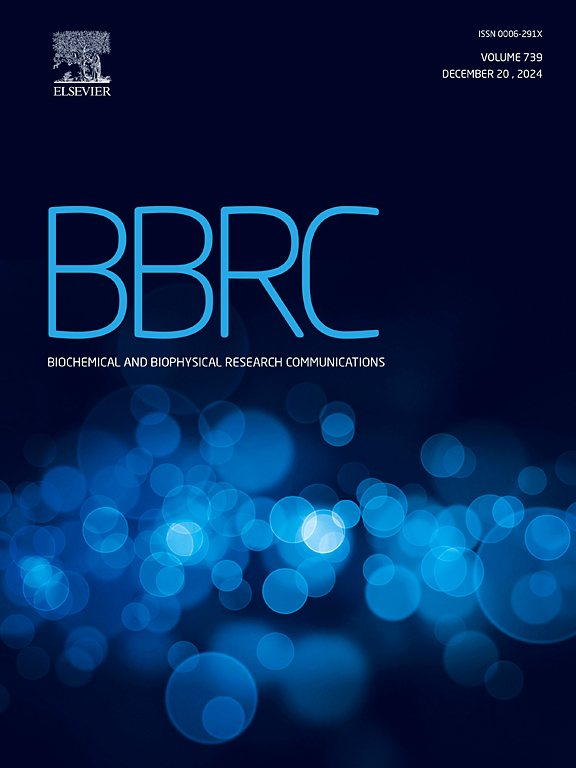Thermodynamic role of receptor phosphorylation barcode in cannabinoid receptor desensitization
IF 2.5
3区 生物学
Q3 BIOCHEMISTRY & MOLECULAR BIOLOGY
Biochemical and biophysical research communications
Pub Date : 2025-01-01
DOI:10.1016/j.bbrc.2024.151100
引用次数: 0
Abstract
The endocannabinoid signaling system is comprised of CB1 and CB2 G protein-coupled receptors (GPCRs). CB2 receptor subtype is predominantly expressed in the immune cells and signals through its transducer proteins (Gi protein and β-arrestin-2). Arrestins are signaling proteins that bind to many GPCRs after receptor phosphorylation to terminate G protein signaling (desensitization) and to initiate specific G protein-independent arrestin-mediated signaling pathways via a “phosphorylation barcode”, that captures sequence patterns of phosphorylated Ser/Thr residues in the receptor's intracellular domains and can lead to different signaling effects. The structural basis for how arrestins and G proteins compete with the receptor for biased signaling and how different barcodes lead to different signaling profiles is not well understood as there is a lack of phosphorylated receptor structures in complex with arrestins. In this work, structural models of β-arrestin-2 were built in complex with the phosphorylated and unphosphorylated forms of the CB2 receptor. The complex structures were relaxed in the lipid bilayer environment with molecular dynamics (MD) simulations and analyzed structurally and thermodynamically. The β-arrestin-2 complex with the phosphorylated receptor was more stable than the non-phosphorylated one, highlighting the thermodynamic role of the receptor phosphorylation. It was also more stable than any of the G protein complexes with CB2 suggesting that phosphorylation signals receptor desensitization (end of G protein signaling) and arrest of the receptor by arrestins. These models are beginning to provide the thermodynamic landscape of CB2 signaling, which can help bias signaling towards therapeutically beneficial pathways in drug discovery applications.
受体磷酸化条形码在大麻素受体脱敏中的热力学作用。
内源性大麻素信号系统由CB1和CB2 G蛋白偶联受体(gpcr)组成。CB2受体亚型主要在免疫细胞中表达,并通过其换能器蛋白(Gi蛋白和β-arrestin-2)发出信号。阻滞蛋白是一种信号蛋白,在受体磷酸化后与许多gpcr结合,终止G蛋白信号传导(脱敏),并通过“磷酸化条形码”启动特定的G蛋白非依赖性阻滞蛋白介导的信号传导途径,该途径捕获受体胞内区域磷酸化Ser/Thr残基的序列模式,并可导致不同的信号传导作用。由于缺乏与阻滞蛋白复合物磷酸化的受体结构,阻滞蛋白和G蛋白如何与受体竞争以获得有偏的信号,以及不同的条形码如何导致不同的信号谱的结构基础尚未得到很好的理解。在这项工作中,β-arrestin-2的结构模型与CB2受体的磷酸化和未磷酸化形式相结合。采用分子动力学(MD)模拟方法对其在脂质双分子层环境下进行松弛,并进行了结构和热力学分析。具有磷酸化受体的β-arrestin-2复合物比未磷酸化的复合物更稳定,突出了受体磷酸化的热力学作用。它也比任何与CB2的G蛋白复合物更稳定,这表明磷酸化信号受体脱敏(G蛋白信号传导的末端)和受体被阻滞。这些模型开始提供CB2信号的热力学景观,这可以帮助将信号偏向于药物发现应用中的治疗有益途径。
本文章由计算机程序翻译,如有差异,请以英文原文为准。
求助全文
约1分钟内获得全文
求助全文
来源期刊
CiteScore
6.10
自引率
0.00%
发文量
1400
审稿时长
14 days
期刊介绍:
Biochemical and Biophysical Research Communications is the premier international journal devoted to the very rapid dissemination of timely and significant experimental results in diverse fields of biological research. The development of the "Breakthroughs and Views" section brings the minireview format to the journal, and issues often contain collections of special interest manuscripts. BBRC is published weekly (52 issues/year).Research Areas now include: Biochemistry; biophysics; cell biology; developmental biology; immunology
; molecular biology; neurobiology; plant biology and proteomics

 求助内容:
求助内容: 应助结果提醒方式:
应助结果提醒方式:


